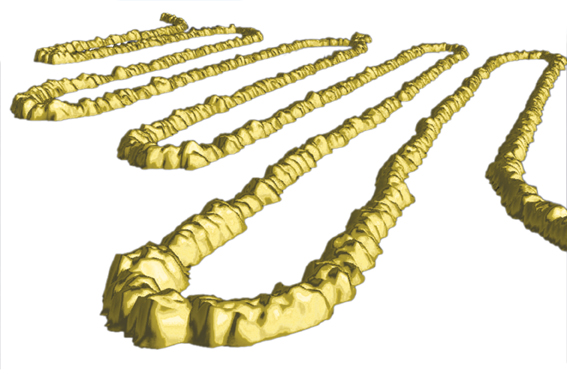King Midas may have turned everything he touched to gold, but he never got to lay his hands on carbon nanotubes. This achievement fell to Prof. Ernesto Yoslevitz and research student Tohar Jordan, from the Department of Materials and Surfaces in the Faculty of Chemistry at the Weizmann Institute of Science

King Midas may have turned everything he touched to gold, but he never got to lay his hands on carbon nanotubes. This achievement fell to Prof. Ernesto Yoslevitz and research student Tohar Jordan, from the Department of Materials and Surfaces in the Faculty of Chemistry at the Weizmann Institute of Science. Recently, the two used a method developed in Prof. Yoslevitz's laboratory, which allows controlling the production of carbon nanotubes to create, among other things, nanowires with complex shapes coated with gold.
Two years ago, Prof. Youslevitz and the members of the research group headed by him began to create long and thin nanotubes with bends, loops and twists, including "curvy" shapes reminiscent of radiators. Such curved nanotubes may, in the future, be used as components in tiny electrical devices. It is interesting to note that these tiny and neat shapes organize themselves independently. The scientists created a kind of "orderly disorder", where random fluctuations drive the self-organization and its direction, and with this method they managed to "draw" any shape.

Now the researchers are beginning to coat these nanotubes with gold, using a process called electrical deposition: sending electrical pulses through a solution containing metal ions causes them to leave the solution and attach to the nanotubes. So far, the method has yielded beautiful golden pieces, but the goal of the researchers is not to design nanojewelry, of course, but, as Prof. Youslevitz says, "to combine the unique geometry of the curved nanotubes with the properties of other materials." Using the method - which was published in the journal Nano Letters and was nicknamed "painting with nanotubes" - it is possible to produce nanowires from any conductive or semi-conductive material. In addition to gold, they also coated the curved nanotubes with a material called bismuth telluride. This material is able to convert heat into electricity, or, alternatively, when an electric current is passed through it, it cools. Telluride bismate nanowires may in the future form a kind of tiny battery in microscopic devices, or be used as tiny cooling units in nanoelectronic devices.
In the meantime, the team continues its attempts to produce curved nanowires from a variety of materials. One of the latter, for example, yielded filaments that might be used as tiny photoreceptors, or even as fluorescent nanolights.

2 תגובות
Can someone explain to me what is so special about nano tubes that everyone keeps talking about? What is so special about this elongated tube-like shape? How are they better than just square or round particles of the same size?
This is the future of electronics